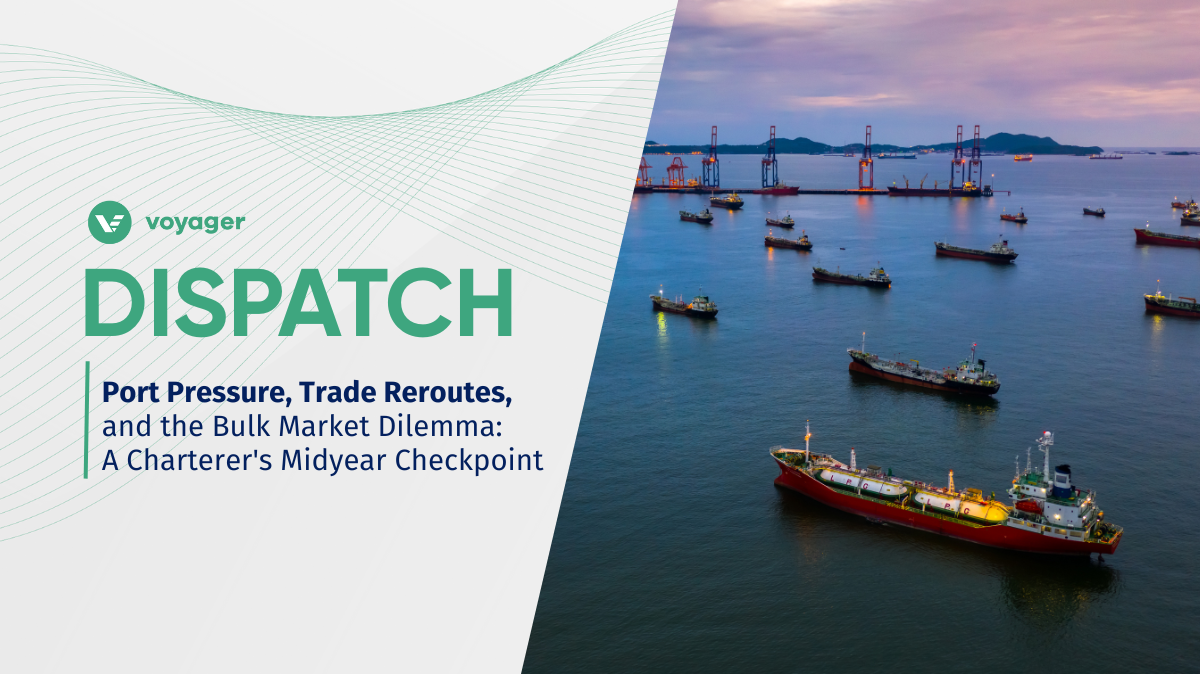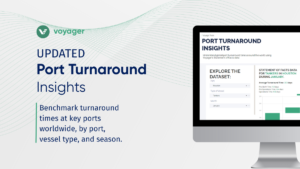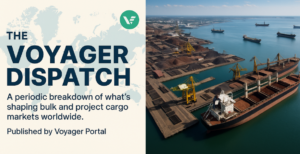As midyear uncertainty mounts, charterers face a volatile mix of stubborn supply chain chokepoints, policy ambiguity, and freight market fragmentation. The weeks ahead may test contractual discipline as much as operational agility.
Charterers operating across bulk and energy markets are entering the back half of Q2 with more questions than answers. While global trade volumes remain resilient in headline terms, a closer look reveals tightening corridors, shifting demand centers, and tariff-induced turbulence muddying planning horizons. From rising political risk in transatlantic trade to diverging freight flows across the Pacific and Atlantic basins, the current environment calls for sharper tools—not just sharper instincts.
Dry Bulk | The Signals are Mixed, But Mostly Muffled
The dry bulk market is currently offering neither clarity nor confidence. While Capesize rates rebounded late last week, they did so from a low base. Large bulk carriers have seen sporadic upticks tied to iron ore volumes out of Brazil and Australia, but the broader trend remains muted. Mid-sized vessels continue to grapple with demand softness, and forward fixtures suggest little in the way of seasonal uplift.
As Alexis Ellender of Kpler cautions, “The market hasn’t woken up enough to the risk to demand in the fourth quarter for bulkers that carry grain.” That framing captures the mood across much of the segment, particularly for Panamax and Ultramax vessels exposed to US soybean flows.
Meanwhile, US agriculture continues to navigate structural headwinds. Despite a record global grain output, American farmers are facing lower margins amid tight fertilizer supplies and limited export upside due to ongoing tariff regimes. The cumulative effect: muted cargo flows and increased chartering risk on backhaul routes.
With China maintaining tight inventory control and Southeast Asia sourcing more regionally, Atlantic tonnage is increasingly exposed to imbalance. For charterers, this means revisiting how they model risk across Atlantic-Pacific triangulations—and preparing for positional inefficiencies to persist into Q3.
Wet Bulk | VLCC Restraint and the Return of Sanction Risk
In the tanker segment, the narrative is less about rates and more about readiness. A string of new sanctions tied to Iran’s shadow fleet has reintroduced a layer of compliance risk that could reshape route planning and delay fixtures.
At the same time, VLCC spot market activity has cooled, with major players opting for restraint on long-term contracts. Frontline CEO Lars Barstad noted, “This market will pay us back, but not on forward commitments”—a signal that owners are betting on stronger rates later in the year while avoiding locked-in exposure now.
For charterers, this could translate to tightening availability at short notice, especially on long-haul crude trades. Meanwhile, bunker prices have offered brief respite, with the G20 VLSFO Index dropping to a two-week low. Still, the broader cost base remains vulnerable to shifts in geopolitical sentiment and supply disruptions.
Other Developments | Tariffs, Delays, and the Case for Optionality
On the geopolitical front, fresh tariff threats targeting Europe have rattled global trade forecasts and pushed some charterers to front-load bookings. The effects are already visible in transatlantic freight behavior and pricing. Simultaneously, northern European ports continue to face delays likely to extend into July, compounding operational pressure.
Against this backdrop, digital planning tools are seeing renewed interest. As Don Mabry, Senior Vice President of Global Trade Solutions at Infios, recently noted writing for Logistics Viewpoints, “The ability to simulate policy shocks and reroute around them is no longer optional. It’s the new baseline for global logistics.” While his focus is on broader supply chains, the message is clear for charterers too: static planning is a liability. The next wave of gains will come from visibility and optionality—not just price.
Conclusion
For charterers, this week underscores a deeper truth: macro volatility is not a temporary nuisance but a structural condition. From dry bulk hesitation to wet bulk recalibration and the policy-driven shocks playing out in between, every fixture is now a negotiation with uncertainty—shaped increasingly by freight market fragmentation across basins and cargo types.
The firms best positioned for the second half of the year will not be those chasing short-term rate advantages, but those investing in better information, flexible contracts, and proactive risk management. A volatile market punishes the reactive—and rewards the prepared.
Before You Go…
CHECK OUT OUR NEW TOOL!
Explore our updated Port Turnaround Insights—a free tool to benchmark time in port by vessel type, cargo, and season. It’s just a snapshot of the data our clients use to improve planning and reduce demurrage exposure.
GET OUR LATEST PLAYBOOK
Download our latest eBook, The Steps Behind Managing a Demurrage Claim, and learn how to review claims more effectively, reduce error rates, and negotiate with confidence.
Follow The Voyager Dispatch on LinkedIn
Our weekly newsletter tracks global dynamics shaping chartering, demurrage, and freight. Want updates delivered straight to your feed? Follow us on LinkedIn to never miss a Dispatch.




